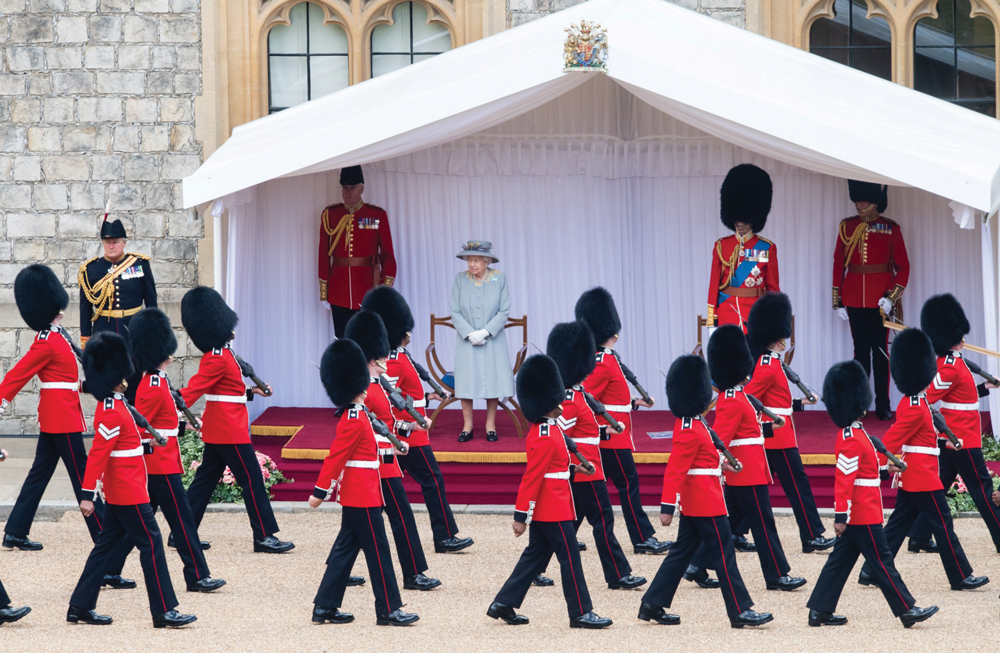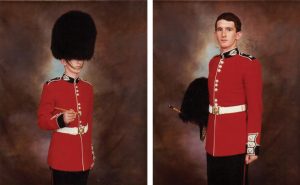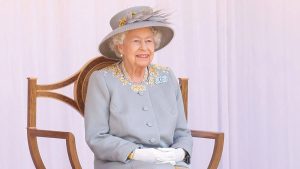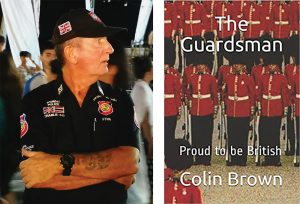Trooping the Colour
By Colin Brown

Last month the Queen’s official birthday saw a paired down version of the Trooping of the Colour taking place at Windsor Castle. Here in Pattaya we have a former Scots Guard: Colin Brown who shares with us his memories of how it was done in his day with an excerpt from his book “The Guardsman”. Ed
For the Brigade of Guards, the most important occasion of the year is the Trooping of the Colour or as it is known the ‘Queen’s Birthday Parade’. This takes place on Horse Guards Parade. Fifteen hundred men and horses marching around a gravelled parade ground, supported by the massed bands and pipes and drums of the regiments. This is a military spectacle to rival, or surpass, any other in the world. It is attended by hundreds of VIPs from all over the globe, who come to pay their respects to the Queen on her birthday.
 The whole parade is as complicated as it can get. The build-up to the Troop starts three months before and takes a huge amount of time and planning considering there are 7 regiments taking part, all located in different parts of the country. All have to rehearse together at some point. The logistics alone take hundreds of man hours to organise. All the feeding, clothing, transport and repairs for any equipment needed for the parade must be dealt with. A lot of time and effort is put into getting things ready for the big day.
The whole parade is as complicated as it can get. The build-up to the Troop starts three months before and takes a huge amount of time and planning considering there are 7 regiments taking part, all located in different parts of the country. All have to rehearse together at some point. The logistics alone take hundreds of man hours to organise. All the feeding, clothing, transport and repairs for any equipment needed for the parade must be dealt with. A lot of time and effort is put into getting things ready for the big day.

Some of the first rehearsals take place at North Weald airport (a Second World War fighter base) where, after getting up at 0200hrs and jumping on buses, we would start marching around the runway at 0500hrs. It always seemed a bit unreal, hundreds of men wearing Bearskins and ammo boots marching around in the dark. Then back to barracks before the traffic and more drill on the square for the rest of the day. It was tedious to say the least, but it does show the commitment to the event.
Months and months of practice follow, and two full rehearsals, in which the Queen’s Lady in Waiting takes the place of Her Majesty. On these occasions, you can get tickets (if you’re lucky). For everyone involved, it is a long and tiring day, whether you are on the actual Troop, gutter sniping or doing any of the background tasks. The day starts at 0530hrs with PT on the square, then a shower and breakfast. For anyone taking part in the Troop, breakfast is OTA (ordered to attend). When anything in the British army is marked as OTA, failure to turn up results in jail time. The reasoning behind the compulsory breakfast is to help maintain energy levels and make sure you do not dehydrate. The Troop is also one of the only times when you are issued with sweets (barley sugar) to give you a further blood sugar boost. Then back onto the square for another practice before heading back to your room to get changed into uniform for the main parade.
long and tiring day, whether you are on the actual Troop, gutter sniping or doing any of the background tasks. The day starts at 0530hrs with PT on the square, then a shower and breakfast. For anyone taking part in the Troop, breakfast is OTA (ordered to attend). When anything in the British army is marked as OTA, failure to turn up results in jail time. The reasoning behind the compulsory breakfast is to help maintain energy levels and make sure you do not dehydrate. The Troop is also one of the only times when you are issued with sweets (barley sugar) to give you a further blood sugar boost. Then back onto the square for another practice before heading back to your room to get changed into uniform for the main parade.
The parade also takes place in high summer when the temperatures can soar and the parade square is a natural sun trap. Kept waiting there an hour before the parade starts, it is a recipe for disaster with people dehydrating and starting to faint from the heat. By the time the Queen arrives everyone is happy to get going, if just to stretch their legs, loosen their tired muscles and get on with the parade. Once everything has started it usually goes as planned, after all the practice, but whether it is a good parade will only be known later after a debriefing of all the senior ranks. Things like the march past; were all the lines straight as they marched past the Queen? Did the officer give the correct commands and could he handle his horse on the complicated manoeuvres? etc., etc., the list is endless.
As the whole parade is live on TV, and watched all over the world, no one wants to give the impression that the parade was not perfect. If there are any blatant mistakes, careers can be broken, reputations take a battering, and you can end up with a black mark against your name.
Colin’s book is available to purchase on Amazon
